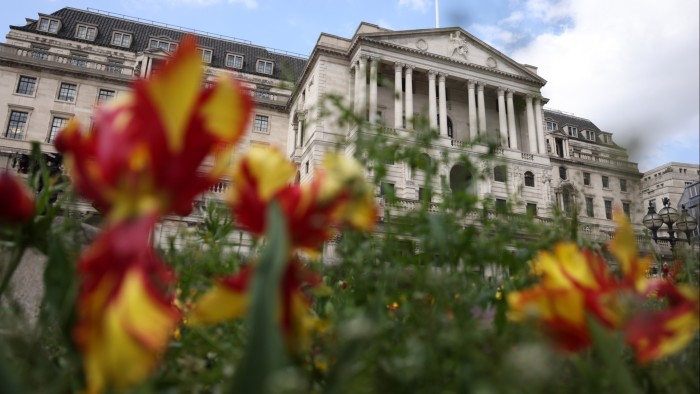Unlock the Editor’s Digest for free
Roula Khalaf, Editor of the FT, selects her favourite stories in this weekly newsletter.
Investors are bracing for an April surge in UK inflation that could test the Bank of England’s resolve in lowering interest rates this year.
Figures on Wednesday are expected to show annual consumer price inflation of 3.3 per cent last month, up from 2.6 per cent in March, according to economists polled by Reuters. The increase comes amid rises in employers’ national insurance contributions, utility bills and taxes, as well as the announcement of higher US import tariffs.
Services inflation, an indicator of domestic price pressures closely watched by the Bank of England, is forecast to rise to 4.9 per cent in April, from 4.7 per cent the previous month.
“The UK is entering a protracted period of above-3 per cent CPI inflation,” said Rob Wood, chief UK economist at Pantheon Macroeconomics.
The BoE has cut interest rates four times since the summer of 2024, as inflation declined from the multi-decade high reached in October 2022. However, concerns over a renewed burst of price rises could restrain the central bank from going much further.
After inflation fell more than expected in March, “the April inflation will present the biggest test for [BoE rate setters] this year”, said Sanjay Raja, an economist at Deutsche Bank.
Markets are currently pricing one or two quarter-point rate cuts before the end of the year.
However, uncertainty over the figures is high due to the many changes in fixed prices last month. Speeches by BoE policymakers Sarah Breeden, Swati Dhingra and Huw Pill later in the week will offer investors further clues about their implications for borrowing costs.
Separate data on Friday will show whether retail sales were hit by rising prices.
Ellie Henderson, an economist at Investec, expects a 0.3 per cent month on month rise, helped by the increase in the national living wage and the sunniest April since comparable data began in 1910. This “would set the scene for what could be another quarter of fairly solid consumer spending growth, for now withstanding the gradual cooling in the labour market”, she said. Valentina Romei
How have US companies reacted to the changing tariff landscape?
Business activity data will offer clues about how US companies are responding to President Donald Trump’s stop-start trade war.
S&P Global is due to release on Thursday the latest purchasing managers’ index data, reflecting business activity levels from early to mid-May.
Last month’s figures, covering the initial weeks after Trump announced and then paused steep global tariffs, showed a 16-month low in business activity growth.
Economists polled by Reuters anticipate a further slowdown, with manufacturing PMI forecast to fall to 50 from 50.2 in April and the equivalent services figure is expected to edge down to 50.7 from 50.8.
A reading above 50 indicates expansion, while a fall below that level signals contraction.
The data would be released against “a very choppy macro backdrop with countering signals”, said Manulife John Hancock Investments co-chief investment strategists Emily Roland and Matthew Miskin, noting that weakening manufacturing PMI data had historically been correlated with slowing growth.
“We will need to wait a couple months to see if the global manufacturing cycle continues to decelerate,” the strategists said. Will Schmitt
Will the RBA cut rates on Tuesday?
Australia’s central bank is on Tuesday widely expected to cut interest rates for the second time this year, leaving investors focused on the outlook of policymakers for the rest of the year.
Futures are implying a 96 per cent chance of a cut at the Reserve Bank of Australia policy meeting. The RBA reduced rates for the first time in more than four years in February but held at its last meeting in April.
Ben Wiltshire, a G10 rates trading strategist at Citi, is also anticipating a cut but thinks markets are underpricing the chance of a hold.
“If you look at the labour market in isolation, it’s quite tight,” Wiltshire said.
“If you look at all the G10 central banks, the Aussie central bank is one of the best placed to engineer a soft landing.”
The anticipated cut was unlikely to have much impact on the Australian dollar, according to Jane Foley, a senior currency strategist at Rabobank. But data this week showing faster than expected wage growth could encourage the RBA to deliver a hawkish message to markets, even as it reduces borrowing costs, Foley said.
She expects the RBA to cut rates just once more this year following next week’s meeting, in contrast to the two subsequent moves priced in to markets. William Sandlund


